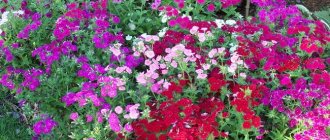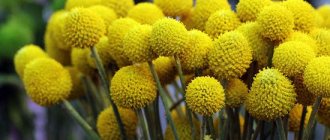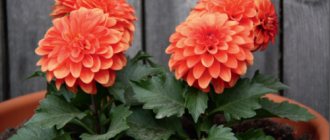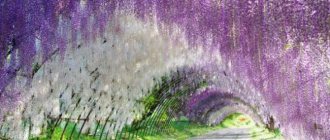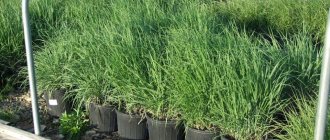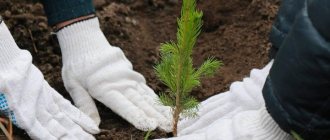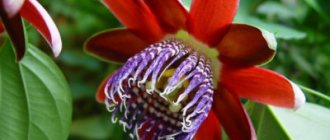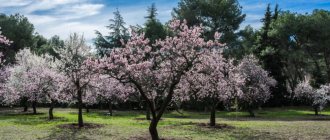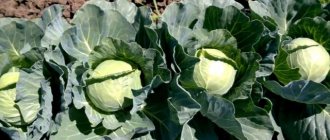Diseases and pests of Diascia
The plant is resistant to pests and diseases, but under certain growing conditions it can get sick.
- In rooms with dry air, whiteflies and aphids may appear on shoots and leaves. The fight against them consists of treating the plant with insecticides.
- With excess moisture, diascia can develop fungal diseases in the form of stem or horse rot. In this case, treatment with fungicidal preparations is necessary.
- Creeping shoots of hanging plants grown in the ground can be attacked by snails or slugs. In this case, the stems are lifted from the ground and tied to supports.
Diascia in landscape design
Diascia is a perennial hanging plant that is best planted on an alpine hill, in a flowerpot or hanging pot. To fill the empty space between other plants, the flower can be planted in a flower bed. Diascia also looks great when planted alone or in a composition with other flowers. In addition, the plant can be planted to decorate a garden path and a small paved area. The flower looks impressive in a hanging balcony container or a tall flowerpot. Its long stems will hang beautifully, creating a floral firework display.
Diascia flowers in a basket in a composition with other flowers
Botanical description
This flower, from the Norichaceae family, is common in South Africa and grows in warm places with abundant watering and sunbathing as a perennial plant. Diascia is very beautiful in all its manifestations and is used as a crop whose stems and flowers can be used to create soil covers. At the moment there are about 50 species of these flowers.
The root structure of the plant is located in the surface layer. In this case, straight or curly stems creep, and the leaves have a jagged shape and position opposite to each other. The color of diascia can be completely different - from salmon to dark purple. In the wild, the stems of the plant reach a length of 1 m, and in our gardens they grow from 25 to 60 cm. The flowers are pentagonal with a tubular base. The three lower lobes of the flower form something like a lower lip, and the two upper ones contain spurs.
Diascia growing from seeds and care
When sowing seeds in open ground in May, Diascia blooms in June. Growing by seedling method allows you to get flowering even earlier. Seeds for seedlings are sown already in February-March. The color of Diascia flowers is varied: pink, white, purple. Caring for the diascia is simple. It is enough to look at the photo of Diascia, at its lush flowering, to understand why it is bred so eagerly. It is also practiced to grow diascia at home due to its heat-loving nature.
When planting diascia, sand is added to the ground. It is also better to lay out a drainage layer in the pot. It is advisable to water it a lot. Especially when it blooms. In our climate, even perennial diascia grows like an annual. And let him spend the winter indoors. This is how you can save your favorite diascia from the cold.
This is how you get a lush bush. Next, you need to gradually harden your diassia. They are rooted and kept indoors. SeedsGrowing (propagation) of diascia from seeds is not particularly difficult. It is better to sow seeds in a greenhouse in February.
It is better to plant in open soil in late spring. Usually babies bush early and their development is rapid. Complex fertilizer once a month will be sufficient. Long-acting fertilizers are suitable. Grows well as a house plant.
It has pink flowers and a dark center. Grows in pots and in open soil. This variety is propagated by seeds and cuttings. Diascia 'Elegans' The garden form has a not very clear origin.
But the appearance resembles Diascia felt. Diascia "Vigilant" (D.vigilis) refers to the hanging species. It is good to compress it into hanging baskets. Diascia “Blackthorn Apricot” The variety has different flower color variations: salmon, apricot.
Diascia 'Lilac Belle' (Diascia 'Lilac Belle) The variety is easily propagated by cuttings. A highly decorative, flowering diascia is an ampelous, very delicate plant that came to us from South Africa. With its abundant flowering and spherical bush, Diascia (pictured) is loved by many flower growers not only in Europe, but also in our country. Its cultivation from seeds will be discussed in this article.
There are more than 50 species in the genus, some of them are annual, growing in the lowland part of their natural range, others, residents of mountainous regions, are perennial. This species is most often used as an annual crop, and it is its seeds that are usually sold in flower shops. 25 cm, one of the hardiest species, can grow in partial shade, tolerates frosts down to -15 °C. Thanks to its soft green heart-shaped leaves covered with soft down, it is decorative even without flowers.
The plant is resistant to heat and prolonged rain. When growing diascia from seeds, they are sown in February, pressing them into the surface of the soil without covering them with soil. Among the species of hanging diascia grown in pots, one should also note Diascia vigilante (D. Diascia is a genus of annuals and perennials of the Scrophulariaceae family, native to South Africa. Different varieties and types of diascia usually bloom at different times. The origin of some varieties remains unknown.
Growing from seeds at home
Diascia is grown from seeds. At home, diascia is sowed in February. This is done like this:
- the seeds are first prepared in the refrigerator for 14 days;
- then they prepare the soil. The soil mixture containing peat and sand is poured into a prepared container, which can be used as a wide box;
- the seeds are placed in a container at a short distance. The soil is sprayed with water at room temperature;
- the containers are covered with transparent plastic film or glass and placed in a room where abundant sunlight and a temperature of at least +20 degrees will be provided;
- After 15-20 days, when most of the seeds have sprouted, the seedlings need to be ventilated. Every day, the transparent coating (glass or plastic film) is removed for a short time, which increases with each new day, starting from 15 minutes. After 14 days, when the sprouts have become accustomed to ventilation, the shelter can be removed permanently;
- During the entire growing period, the soil must be sprayed with lukewarm water. At the same time, it is important not to overwater the plant: it does not tolerate excess moisture and may begin to rot;
- Transplantation into the ground or into separate pots is carried out after the sprouts produce a few leaves.
To plant diascia in the ground, choose a warm season: late spring is best. Prepared holes, dug at a distance of 20-25 centimeters from each other, are watered with water, after which the grown seedlings are placed in them.
Planting diascia in open ground
What time to plant
Diascia seedlings are planted in the garden only after the ground has warmed up well and spring return frosts have been left behind. As a rule, this time falls in the second half of May. However, before you start planting seedlings in open ground, they should be prepared. To do this, she is moved outside for some time every day, the duration of such sessions is gradually increased. Once the young plants can stay in the garden around the clock, they can be planted in open soil.
Landing rules
To grow a flower, you need to choose a well-lit area that has reliable protection from the wind. Suitable soil should be moist, slightly acidic and not very nutritious. It is recommended to add sand to it. Lowlands where water accumulates are not suitable for planting diascia. It will grow best near the southern wall of any building.
When planting between bushes, you need to maintain a distance of about 15 centimeters. Planted flowers must be well watered.
Growing and care
Reproduction
Propagated by both seeds and cuttings (stem and root).
Seeds
To grow from seeds in open spaces, they are sown in February, simply pressing them into the ground and not covering them with soil.
Seedlings are kept at 18 - 19 °C until germination (1.5 - 2 weeks) and then transferred to a cooler place, air temperature no more than 15 °C.
Miniature seedlings are quite hardy and tolerate picking well. They develop quickly and begin to bush early. You can plant seedlings in open ground at the end of May, the recommended distance is 12 - 15 cm from each other. Flowering will begin by mid-July.
You can sow seeds directly into flower beds in the southern regions in April-May, but they will bloom only at the end of August.
Cuttings
To propagate by cuttings, it is necessary to root healthy stem cuttings in a moistened substrate at the end of summer.
If root cuttings are separated in the fall, the rooted seedlings can overwinter, just like adult plants. Already at the end of spring, plants from cuttings will delight with the first flowers.
Creating favorable conditions
Heat-loving diascia requires a warm, well-lit place and well-drained soil.
It can die from stagnation of water, so it is necessary to add additional drainage to the pots, and when growing in open ground, mix the soil with sand.
The best soil is neutral, sandy loam mixtures or slightly acidic loams.
Watering
Needs regular, abundant watering, especially during flowering and in hot weather.
Top dressing
For feeding, it is advisable to apply special complex fertilizers for flowering plants once a month.
Trimming
Radical pruning is recommended after the first flowering.
Leave shoots up to 5 cm. Then the bush needs to be watered and fed generously.
For long-term flowering, it is necessary to constantly remove wilted and faded flowers.
Wintering
Annuals cannot tolerate sub-zero temperatures. In autumn, Diascia bushes can be removed or dug up and stored in a well-lit room at an air temperature of +5C.
Having cut the shoots in half, the plant itself is transplanted into containers with fresh soil. Before planting in the ground in the spring, the preserved bushes are hardened off by exposing them to fresh air on warm days for several hours.
Be sure to feed the flowers on the site before they bloom.
Types and varieties of diascia with photos and names
Diascia fetcaniensis
The rounded, relatively small leaf plates are painted in a pale green shade. On their surface there is dense pubescence consisting of soft hairs. The length of the peduncles reaches about 25 centimeters; they form flowers of a dark pink color, on the surface of which there are many red streaks. The diameter of the flowers reaches approximately 20 mm; due to the presence of a spur directed forward, they have a very impressive and unusual appearance. This species is not afraid of frosts down to minus 15 degrees.
Diascia rigescens
In the southern and western parts of England this species is cultivated as a perennial, but in Holland it freezes out in winter. The length of the stems is about half a meter. The bulk of the foliage is located at the base of the bush; in autumn it turns brownish-red. Dark pink flowers reach about 20 mm in diameter.
Diascia barberae
In temperate climates, this species is an annual that has a branched bush, reaching a height of about 0.3 m. Flowering begins after the length of the shoots is 7–10 centimeters. Glossy small leaf blades, painted dark green, are mainly located at the base of the bush. Many flowers are formed on the peduncle, reaching about 15 mm in diameter, which can be painted in various shades of pink, and have a yellow spot in the throat. The best varieties:
- Pink Queen. The pinkish flowers have a milky tint.
- Apricot Queen. The bushes are decorated with orange inflorescences.
- Salmon Queen. The flowers are pinkish-orange.
- Basya. This annual blooms twice in one season. Velvety drooping flowers of deep pink color reach about 20 mm in diameter.
- Ruby Field. Inflorescences are dark pink.
Diascia Blackthorne Apricot
This hybrid has lodging shoots, and large spur flowers, they are colored in warm shades of pink: from salmon pink to light apricot.
Diascia Elegance
Experts do not know how this hybrid garden form came about. This plant is distinguished by its unpretentiousness and power. Its drooping shoots are decorated with lush, glossy dark green foliage. The pinkish flowers have a dark spot in the throat.
Jack Elliot
This garden variety of unknown origin can reach a height of about 0.4 m. Lush glossy foliage of a rich green color grows on the stems. Cherry-red or dark pink flowers reach at least 2.5 cm in diameter. They have a purple spot in the throat, and a yellow depression is clearly visible above it.
Lylek Bell
This garden form is very popular among gardeners and is often grown for sale. The bush has a height of approximately 0.3 m, while the length of the foliage is about 40 mm. Not very long lush peduncles consist of many small flowers reaching up to 1.5 cm in diameter, their corolla is flattened, and in the pharynx there is a speck of a yellow tint. This form is great for filling the space between large plants, and also for creating compositions in containers.
Other perennial hanging plants
You can also use other hanging flowers to decorate your home or in landscape design.
Rhipsalis - ampelous forest cactus
The ampelous cactus is unpretentious in cultivation and is propagated by seeds or cuttings. The plant has thin and long stems, on which small but very beautiful flowers appear. A blooming chylocereus cactus looks quite elegant and decorative. Such a beautiful and soft thorn is suitable for decorating your home or any office.
Ampelous cactus in a flowerpot
Begonia ampelous tuberous
This type of begonia is distinguished by many double or semi-double beautiful flowers, which are located on long stems. Begonia blooms almost all year round, which gives it special value. You can propagate such begonia by simply cutting the tuber and rooting it. Anyone can easily grow the flower if they know how to plant tuberous begonia and how to care for it.
Ampelous tuberous begonia in a flowerpot
Catharanthus (periwinkle) ampelous
Periwinkle ampelous Riviera has long stems that are capable of rapid growth and branching. It blooms with large, long-lasting and dense flowers of blue or purple hue. The flowering period is quite long - from the end of May to the last days of August.
How the ampelous periwinkle blooms
Bacopa ampelous
The ampelous bacopa plant is an annual or perennial that can be grown for several years in a row. As a rule, in warm climates, bacopa is grown as a perennial, and is simply covered well during the cold season. In northern regions, the plant is most often grown as an annual, since it is impossible to determine whether it will survive or not in severe frost.
The description of bacopa says it is a plant with long stems, small green-olive leaves, arranged in pairs on the shoots. This is an ampelous flower, which, depending on the variety, amazes with a variety of shades. There are very surprising varieties of bacopa plants, for example, Scopia Double Lavender, whose flowers have two-tiered petals.
Bacopa ampelous in a flower pot
Blue
Bacopa blue has a long flowering period. Does not require special attention or any special care. It can be planted not only in hanging flowerpots, but also used for planting in open ground.
Pink
Bacopa rosea has long shoots (up to 60 cm) with beautiful openwork leaves and delicate flowers that are colored lavender. The flower goes well with petunia.
Blue avalanche
This variety has long drooping stems and many green leaves. Flowers come in both lilac and blue. It has a fairly long flowering period. Growing Bacopa Blue Avalanche is possible through seeds and also by cuttings.
Lilac
Bacopa lilac has long stems, lush, dense foliage and small lilac flowers. Does not need a lot of light and grows well in the shade.
Caroline (Bacopa Caroliniana)
The peculiarity of the variety is its long light green leaves, which, under the influence of direct sunlight, change their color to a copper-red hue. The flowers are bright blue and small. Grows well in the shade.
Gulliver Pink
Bacopa Gulliver Pink is distinguished by a lush bush, as well as pink and fairly large flowers. This variety is considered quite capricious to grow.
Bacopa Monnieri (Bacopa Monnieri Psychosis)
This plant is also called small-leaved bacopa. It is distinguished by long creeping stems with small leaves. The leaf blade has an oblong shape and a rounded top. Leaf length 0.8-2 mm. The flowers are small, white, blue or purple.
For your information! The Bacopa Monnieri plant is used in Zhud Shi (Tibetan medicine).
Home hanging plants will decorate a window or balcony, and will also become an elegant element in landscape design. There is plenty to choose from - diascia, bacopa, catharanthus and others.
Diascia propagation methods
The plant can be propagated in two ways:
Propagation by seeds
Seeds for seedlings are sown in February. Plants grown this way will bloom in July.
Sowing is done in containers filled with soil. The seeds are not sprinkled with soil, but simply pressed in and sprayed with warm water. The seedling boxes are covered with glass and put away in a warm place. The first crops should appear in 10-25 days.
When the first sprouts appear, the boxes are placed in a well-lit but cooler place with an air temperature in the range of +15-+17C. As soon as two or three true leaves appear, the seedlings dive. Caring for them consists only of keeping the soil moist. Diascia seedlings are very viable, grow quickly and bush early.
At the end of May, ampelous diascias, several bushes at a time, are planted in a hanging basket, and plants with erect stems are planted in open ground at a distance of 15 cm between plants.
Diascia seeds can be grown directly in open ground. However, in this case, flowering will begin only in August.
Propagation by cuttings
You can take cuttings from bushes dug up in the fall and saved in the spring. Cuttings with 3-5 leaves take root in a moist substrate. After about a month, their tops will need to be pinched. Rooted plants in open ground are planted in spring in a well-lit area protected from cold winds.
Diascia can also be propagated by root cuttings, which are separated from the main plant in the fall. The cuttings are planted in pots filled with soil, in which they overwinter in well-lit, cool rooms. To enhance bushiness, the cuttings are pinched after rooting. Diascias propagated by cuttings will bloom at the end of May.
Growing Diascia from Seeds
Sowing
As a rule, diascia from seeds is grown by seedlings. Sowing seeds for seedlings is carried out in the last days of February or the first days of March. To do this, use cassettes that are filled with loose soil. You need to sow 3 seeds in each cell. Also, wide bowls are sometimes used for sowing. In this case, the seed material is combined with sand (1:5) and sowing is carried out. There is no need to cover the seeds with soil on top; instead, they are only slightly pressed into a pre-moistened substrate, and then the container is covered with glass (film) on top. A slightly acidic soil mixture with a low nutrient content, which consists of sand and garden soil, is suitable for growing seedlings.
Growing seedlings
In order for seedlings to emerge from the seeds, the air temperature should be maintained at a level of 18 to 20 degrees. The first seedlings should appear after 10–15 days. Immediately after this, the containers with the crops are transferred to a cool place (10 to 15 degrees). Remember that you should not allow the soil mixture in the container to dry out, but also make sure that the liquid in it does not stagnate under any circumstances. It is recommended to water immature seedlings using a sprayer. When growing seedlings in a bowl, 15 days after germination, they will need to be planted into individual cups.
During the growth of the seedlings, you will need to pinch the tops of its shoots several times, in this case the bushes will grow denser and more spectacular. If seedlings of ampelous varieties are grown, then after they have grown and become stronger, they are planted in pots or containers.
Diascia 03/19/18 Development of Diascia seedlings
Caring for diascia at home
In indoor conditions, mostly ampelous varieties of diascia are cultivated, which are quite easy to care for. While the bushes are young, their shoots are straight, just like the bush varieties. However, when the height of the stems is approximately 30 centimeters, they will begin to fall down.
Landing
At the bottom of the planting basket or pot, make a good layer of drainage, which can protect the root system of the flower from stagnation of liquid in the substrate. The soil mixture for growing diascia should be slightly acidic, loose and containing a small amount of nutrients. The optimal composition of the substrate is: wet peat (or leaf soil), garden soil and perlite (or coarse sand), taken in equal parts.
Watering and fertilizing
Watering should be plentiful, but moisture should not be allowed to stagnate in the substrate. The plant is fed regularly once every 15–20 days; for this purpose, liquid mineral fertilizer is used in low concentration. Organic matter is not suitable for feeding diascia. Do not overfeed the bush, as this will cause its shoots to weaken, become elongated, and flowers will not form on them.
Trimming
All faded buds, as well as faded stems, must be trimmed in time, in this case the bush will actively grow new shoots. When the first wave of flowering comes to an end, it will be necessary to shorten all existing shoots to 50 mm. Trimmed bushes are watered frequently and abundantly, and fertilizer is added to the substrate. After quite a bit of time, young shoots grow from the bushes, on which the formation of buds is observed. Then the bush blooms again.
Selecting a location
Diascia of ampelous varieties can decorate any room, as well as a terrace, loggia, balcony, veranda or other premises. To plant bushes, use containers or balcony boxes; you can also use hanging structures, namely baskets or flowerpots. The flower looks great in large flowerpots.
Diseases and pests
When grown indoors, such a plant rarely gets sick. As a rule, problems with it arise only when there is an excess of nutrients in the soil mixture. That is why experts advise not to feed the flower at all, in order to avoid overfeeding it.
Taking care of diasia...
...in the flowerbed
Diascia loves to be watered systematically and abundantly, especially when the weather is dry. But, on the other hand, do not over-moisten the soil, and especially do not allow the water to stagnate, as this is fraught with the occurrence of fungal diseases. After watering the flowerbed, loosen the soil thoroughly and, if weeds appear, remove them.
Diascia has a special attitude towards frequent feedings: she simply does not tolerate them well. It is enough to fertilize it once a month with special mixtures of “flower” fertilizers.
IMPORTANT
A diascia “overfed” with fertilizers may either not start at all, or it will bloom, but reluctantly and not for long. And it will stretch upward, losing its inherent decorativeness.
When the first, spring-summer, wave of flowering ends, all branches of the diascia are cut in half and continue to water it abundantly. Soon new young shoots and buds will begin to appear - the next “color” wave will begin.
This plant has pests in the form of slugs and snails. They are usually collected by hand, and the branch-stems are picked up from the ground.
…Houses
For rooms, the most common choice is a hanging diasto. In young seedlings of this variety, the stems do not differ from bushy species, but, having reached a length of 30 cm, they droop and hang picturesquely.
Ampelous diascia is grown in containers or flowerpots, and over time it perfectly decorates both the interior of the room and loggias with balconies.
Planting rules, soil, watering, fertilizing and pruning are practically no different from flowerbed varieties.
In order for the diascia living at home to “produce” new shoots, it is necessary to regularly get rid of dried flowers, inflorescences and leaves.
At home, diascias are not bothered by insect pests and diseases. If the plant does not grow and develop correctly, then these are care errors: the soil is incorrectly selected (diascia does not need one that is oversaturated with nutrients!), and the water stagnates.
Popular types and varieties
Diascia ampelous comes in 50 species, but gardeners prefer to grow only a few of them. Popular types of diascia:
- bearded Forms a compact bush with lush peduncles and small flowers of various colors;
- felt In open ground, this species blooms throughout the summer. The bushes produce many unusual and colorful flowers and glossy leaves, which give the plant additional beauty;
- elegant. The plant is characterized by very small foliage and pink flowers;
- vigilant. This species is distinguished by long trailing stems and beautiful pale pink flowers.
Diascia ampelous salmon color
For your information! Diascia vigilante is capable of sprouting shoots and taking root on its own.
The most popular diascia varieties among gardeners are:
- Pink Queen. This variety has soft pink flowers with bronze edges;
- Blackthorn Apricot. The stems are thick, soft, lodging. Flowers with spurs, apricot or salmon shade;
- Ruby Field. The flowers are pink with a dark center.
How Diascia ampelous blooms magnificently
General information about the plant Diascia
Few people know that the beautifully flowering plant, flowing in half-deciduous form from the alpine hills in the flower beds of intersections, belongs to the Norica family, and bears the mysterious name Diascia (from the Latin Diascia).
The flower's homeland is the mountain slopes of South Africa with abundant rainfall, good lighting and slightly acidic soils. In nature, it grows in fairly drained, loose soils with low nutritional value of the soil.
This graceful and luxurious plant unites approximately 65 annual and perennial stolon species. However, flower growers in the middle zone, taking into account the climate of the region, use diascia as an annual.
Types and varieties
Diascia barbata attracts particular attention .
These include:
- Pink Queen,
- Ruby Field
- felt,
- vigilant,
- elegant and
- harsh.
These varieties are planted along garden and park paths; they harmoniously fill the open space of soil between large plants.
Using upright species on grass, you can create the visual effect of a spot of color, as if floating in the air.
Appearance
In the wild, this is a low-growing flower; the length of the creeping stem can reach 1 meter, but when grown in the garden, the size of the plant, depending on the variety, decreases significantly - approximately 30 - 40 cm.
They are distinguished by types of stems:
- erect,
- creeping or
- lodging.
The flowering period begins in early summer and continues in waves until the first frost.
Small flowers form lush peduncles.
Basic colors of petals in pastel shades:
- pink,
- salmon,
- purple,
- orange and
- white.
The leaves are usually small, shiny, and green in color. A thick cushion is created at the base of the flower. But flower caps can completely hide the leaves.
Among the ampelous species, the most popular varieties of Diascia bearded are: “ Pink Queen ” (light pink inflorescences with a milky tint) and “ Ruby Field ” (the result of crossing heart-shaped and bearded Diascia, characterized by pink flowers with a dark center).
These species tolerate a lack of moisture better than others, so they are preferred to be grown in containers and flowerpots.
Lodging shoots of Diascia vigilante take root on their own. The buds at the tops of the shoots open into pink flowers.
The peculiarity of Diascia tomentosa is its colorful numerous leaves. It decorates rooms, balconies and areas even when not in bloom. In open ground it blooms all summer. The flowers are medium in size, dark pink in color and with red splashes in the middle.
Diascia harsh is attractive because the leaves are light green in color and turn reddish-brown in autumn. This species is one of the most cold-resistant and is grown as a perennial in open ground.
A shrub with lodging or erect stems is Diascia eleganta . Its shoots are strewn with small leaves and pink flowers.
Further care of the plant
It is quite easy to care for the hanging varieties of diascia; you just need to water it in a timely manner, apply fertilizers and prune the bushes.
Watering
The plant is watered as the top layer of soil dries. It is better to water in the morning or evening, so the moisture will evaporate more slowly.
Important! With excessive watering and stagnation of water in the soil, the flower will often get sick and may even die
Top dressing
To feed the flower, only mineral fertilizers are used. The frequency of fertilization is once every 2-3 weeks.
Trimming
Pruning is carried out at the end of the first wave of flowering. All stems are trimmed, leaving only 5 cm above the ground. During the entire flowering season, it is necessary to remove all inflorescences that have bloomed or withered.
Diseases and pests
Diascia is resistant to fungal diseases, but if there is excess moisture in the soil, stem or root rot can develop, which can be eliminated with the help of fungicides.
For your information! During hot weather and with insufficient watering, aphids may appear on the flower. When planting an ampel flower in a flowerbed, it can be attacked by snails and slugs. In this case, the plant should be treated with any insecticide.
Bloom
If the plant is planted through seedlings, flowering will occur in early July. When planting by cuttings - at the end of May. Diascia blooms for periods before the onset of frost.
Flower care
Diascia loves warmth, but excessive heat affects it negatively. In hot weather, the buds may dry out and flowering ends prematurely. Pay attention to the following requirements for caring for diascia in the open ground:
- Watering. Plants in pots are watered more often than in open ground. The soil should always be slightly moist, and there should be no stagnation of water. It is advisable to water in the morning or evening hours so that the moisture does not evaporate too quickly.
- Feeding. Diascia does not require much soil nutrition, and does not tolerate organic matter at all. Many people successfully grow it without using fertilizers at all. If you wish, you can feed it once a month with a solution of mineral fertilizers for beautiful flowering plants. Organic matter causes the shoots to stretch out and flowering stops.
- Trimming. After the first wave of flowering, the shoots of Diascia must be shortened. The stems are cut in half and the plant is not watered for 1 week, after which abundant watering is required. This stimulates the active growth of new shoots and budding. A second wave of flowering occurs.
Among gardeners, diascia is considered an unpretentious plant. In principle, warmth and moisture are all it needs for successful growth and the appearance of inflorescences.

